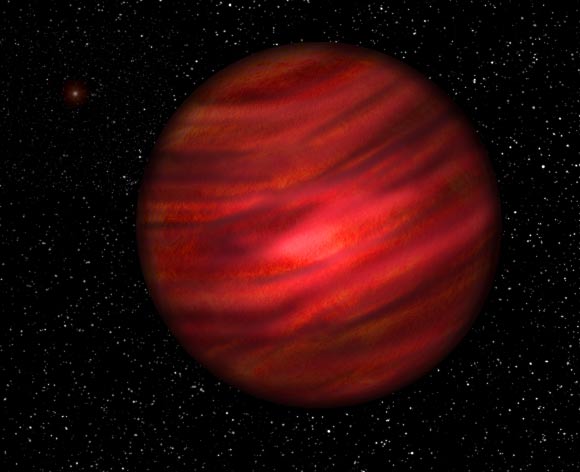The planetary-mass object J2126 – previously thought to be a free-floating planet – orbits its parent star in the most distant orbit seen yet, according to a group of scientists led by Dr Niall Deacon of the University of Hertfordshire, UK.

An artist’s impression of the massive exoplanet J2126. Image credit: Neil Cook / University of Hertfordshire.
J2126 (full name 2MASS J21265040-8140293) is about 13 times the mass of Jupiter.
It orbits approximately 6,900 Astronomical Units from TYC 9486-927-1, an active, rapidly rotating early-M dwarf.
That’s an orbit 6,900 times the distance from the Earth to the Sun, or roughly 643 billion miles (one trillion km). At such a huge distance it takes almost 900,000 years to complete one orbit.
The planet was first spotted in 2008 by Space Telescope Science Institute astronomer Neill Reid and co-authors.
In 2014 a team of astronomers from Canada identified it as a possible member of a 45-million-year-old group of stars and brown dwarfs known as the Tucana Horologium Association. This made it young and low enough in mass to be classified as a free-floating planet.
Until now no one had suggested that J2126 and TYC 9486-927-1 were in some way linked.

This false color infrared image shows TYC 9486-927-1 and J2126; the arrows show the projected movement of the star and the planet on the sky over 1,000 years. Scale bar – 4,000 Astronomical Units. Image credit: 2MASS / Simon Murphy / Australian National University.
Dr. Deacon and his colleagues from Germany, Australia and the United States found that these two objects are moving through space together and are both 104 light years from our Solar system, implying that they are associated.
“This is the widest planet system found so far and both the members of it have been known for 8 years, but nobody had made the link between the objects before,” Dr. Deacon said.
“The planet is not quite as lonely as we first thought, but it’s certainly in a very long distance relationship.”
According to the team, J2126 has a similar mass, age, spectral type, and temperature to one of the well-studied extrasolar planet, beta Pictoris b.
“Compared to beta Pictoris b, J2126 is more than 700 times further away from its host star, but how such a wide planetary system forms and survives remains an open question,” said team member Dr. Simon Murphy, of the Australian National University.
The findings have been accepted for publication in the Monthly Notices of the Royal Astronomical Society (arXiv.org preprint).
_____
Niall R Deacon et al. 2016. A nearby young M dwarf with a wide, possibly planetary-mass companion. MNRAS, accepted for publication; arXiv: 1601.06162







